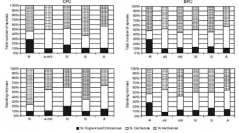

 Geodiversitas
29 (3) - Pages 401-419
Geodiversitas
29 (3) - Pages 401-419During the Plio-Pleistocene several important climatic events constrained faunal renewal phases, affecting the structure of mammal communities, their richness and diversity. In order to complete the analysis of the Pliocene to Pleistocene large mammal faunal renewal in North Mediterranean region, the Greek turnover and diversity patterns from Ruscinian (about 5 Ma BP) to the end of middle Pleistocene (about 175-127 ka BP) are compared with those of Italy and Spain. The analysis takes into account the changes in the taxonomical composition and ecological structure of the Greek, Italian and Spanish succession of regional faunal complexes, which correspond to high rank biochrons (Mammal Ages or Mammal Subages) or they are provided from a cluster analysis. The results indicate a Villafranchian longitudinal diversification from Greece to Spain and a significant early Pleistocene (Galerian) faunal renewal that affected more or less simultaneously the entire North Mediterranean region as a response to the establishment of cooler-dryer climatic conditions around the Jaramillo magnetochron.
Large mammals, Plio-Pleistocene, diversity, turnover, Southern Europe